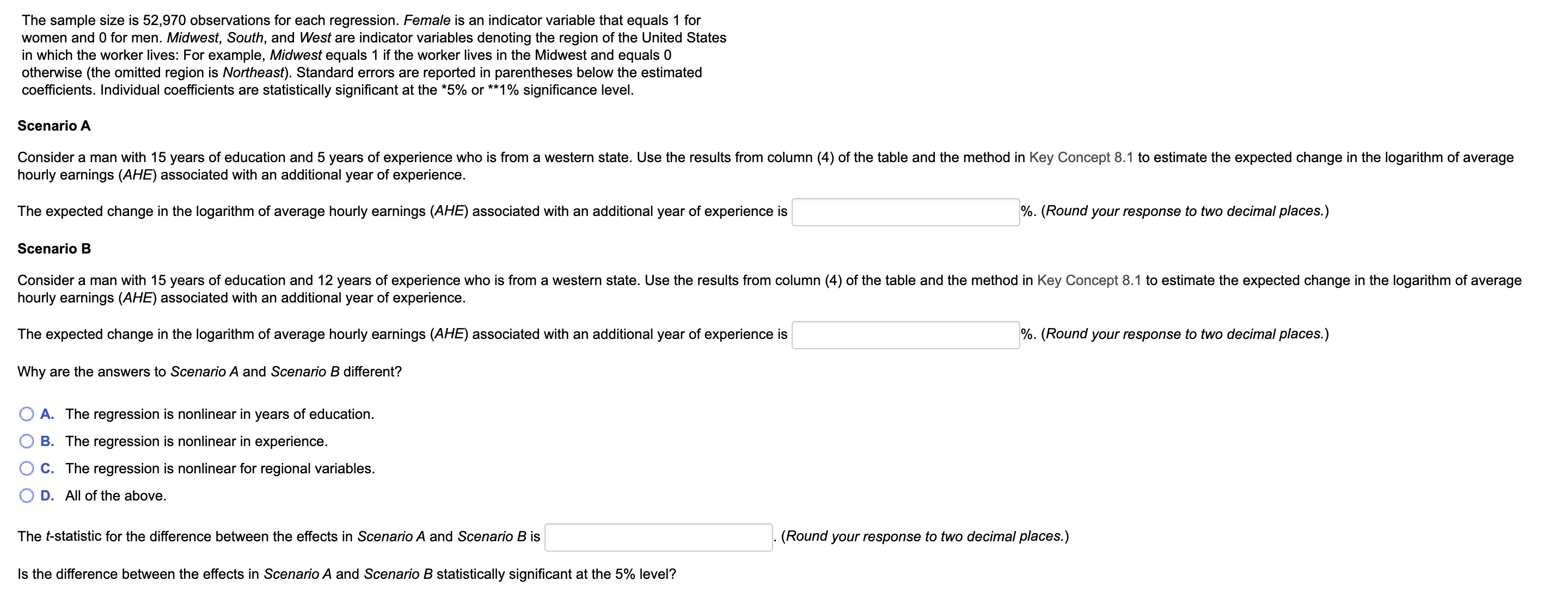can you help me solve these questions. its all combined 1 question. thank you
Read the box "The Return to Education and the Gender Gap." The Return to Education and the Gender Gap Dependent variable: logarithm of Hourly Earnings. Regressor (1) (2) (3) (4) Years of education 0. 1035** 0. 1050* 0.1001** 0.1151** (0.0009) (0.0009) (0.0011) 0.0012) Female - 0.263** - 0.432** - 0.451** (0.004) (0.024) (0.024) Female x Years of education 0.0121* * 0.0134** (0.0017) (0.0017) Potential experience 0.0136* (0.0012) Potential experience - 0.000226** (0.000021) Midwest - 0.095** (0.006) South - 0.092** (0.006) West - 0.028** (0.007) Intercept 1.533** 1.629** 1.697** 1.661** 0.012) 0.012) (0.016) (0.023) R2 0.208 0.258 0.258 0.267 The ~ omnia sion in 50 070 shan union Inmala in an indian that animals 4 forThe sample size is 52,970 observations for each regression. Female is an indicator variable that equals 1 for women and 0 for men. Midwest, South, and West are indicator variables denoting the region of the United States n which the worker lives: For example, Midwest equals 1 if the worker lives in the Midwest and equals 0 otherwise (the omitted region is Northeast). Standard errors are reported in parentheses below the estimated coefficients. Individual coefficients are statistically significant at the *5% or **1% significance level. Scenario A Consider a man with 15 years of education and 5 years of experience who is from a western state. Use the results from column (4) of the table and the method in Key Concept 8.1 to estimate the expected change in the logarithm of average hourly earnings (AHE) associated with an additional year of experience The expected change in the logarithm of average hourly earnings (AHE) associated with an additional year of experience is %. (Round your response to two decimal places.) Scenario B Consider a man with 15 years of education and 12 years of experience who is from a western state. Use the results from column (4) of the table and the method in Key Concept 8.1 to estimate the expected change in the logarithm of average hourly earnings (AHE) associated with an additional year of experience. The expected change in the logarithm of average hourly earnings (AHE) associated with an additional year of experience is %. (Round your response to two decimal places.) Why are the answers to Scenario A and Scenario B different? O A. The regression is nonlinear in years of education. O B. The regression is nonlinear in experience. O C. The regression is nonlinear for regional variables. O D. All of the above. The t-statistic for the difference between the effects in Scenario A and Scenario B is (Round your response to two decimal places.) Is the difference between the effects in Scenario A and Scenario B statistically significant at the 5% level?Consider a man with 15 years of education and 12 years of experience who is from a western state. Use the results from column (4) of the table and the method in Key Concept 8.1 to estimate the expected change in the logarithm of average hourly earnings (AHE) associated with an additional year of experience. The expected change in the logarithm of average hourly earnings (AHE) associated with an additional year of experience is %. (Round your response to two decimal places.) Why are the answers to Scenario A and Scenario B different? O A. The regression is nonlinear in years of education. O B. The regression is nonlinear in experience. O C. The regression is nonlinear for regional variables. O D. All of the above. The t-statistic for the difference between the effects in Scenario A and Scenario B is (Round your response to two decimal places.) Is the difference between the effects in Scenario A and Scenario B statistically significant at the 5% level? O A. Yes. O B. No. How would you change the regression if you suspected that the effect of experience on earnings was different for men than for women? A. Include interaction terms Female x Potential experience and Female x (Potential experience) . O B. Include the interaction term Female x (Years of education). O C. Include interaction terms Male x Years of education and Male x (Years of education)2 . O D. Include the interaction term Male x ( Years of education)2









